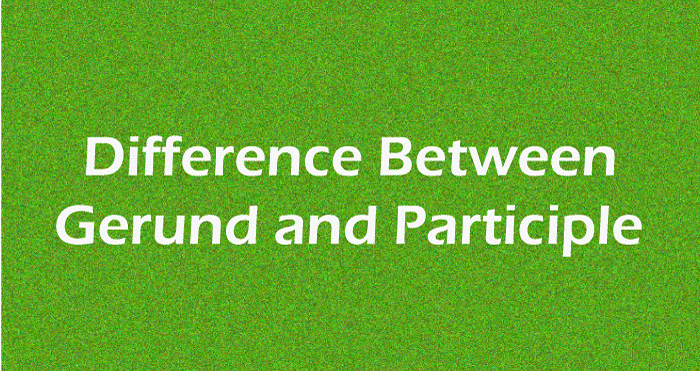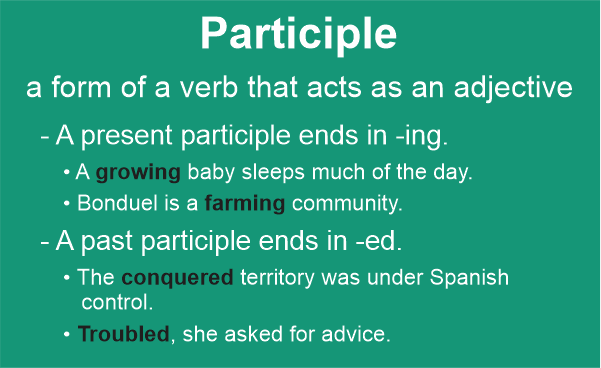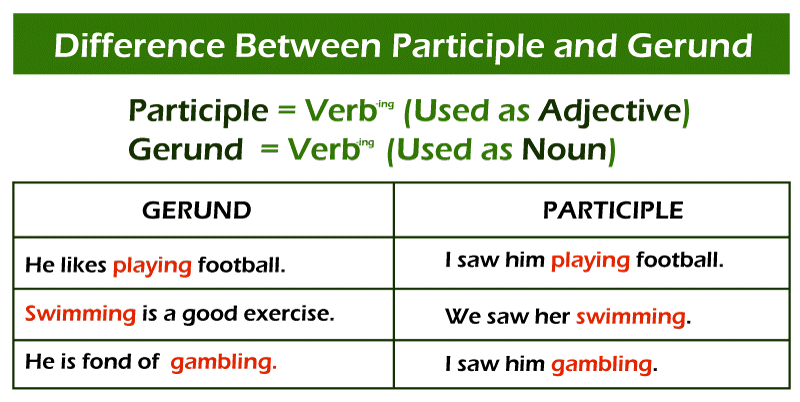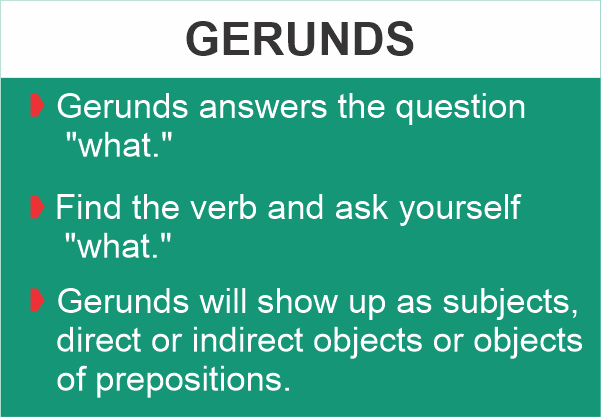Difference Between Gerund and ParticipleA verbal is a term formed from a verb that serves as a noun or modifier in a phrase instead of as a verb. In other terms, a verbal is a verb which serves as the another part of speech. 
Infinitives, gerunds (also referred to as -ing forms), and participles are examples of verbals (also referred to as -ing forms and -en forms). A verbal phrase is a word group based on a verbal. Each of these verbals are most often part of a sentence that also contains relevant modifiers, objects, and complements. Many English learners struggle to differentiate between gerund and participle since the structure of both gerund, and the present participle is identical. The major distinction between these two types is that gerunds are nouns, but the participle are adjectives. What Basically Is a Gerund?A gerund is a verb that concludes with -ing and functions as a noun in a phrase. A gerund is created by appending -ing to the verb's infinitive form. (watch + ing+ = watching, speak + ing+ = speaking) Because a gerund is derived from a verb, it signifies an activity or a state or status of existing or being. A gerund may be a subject, a direct object, a subject complement, or an object of a preposition. As a Subject
As a Direct Subject
As a Subject Complement
As an Object of Preposition
What Precisely Is a Participle?Participle implies to the verb that is employed to describe something. There are 2 kinds of participles. These are

Numerous English learners find it tough to distinguish between the present participle and the gerund since they both finish in -ing. In reality, the composition of the present participle is the same as that of the gerund. For instance, "watching" is utilized as both the present participle as well as the gerund. Because it is based on a verb, the present participle describes a condition of being or activity. However, because participles function as adjectives, they are primarily used to alter nouns and pronouns. A Participle performs the following tasks. Aspects That Are Constant
Adjective
Participle Clauses
A comma must be placed at the end of a sentence that starts with a participle or a participle phrase. As an example, Grinning, she cuddled the baby. Note that if a participle or participle phrase appears in the midst of a sentence, it must be split with commas if the info is not vital to the meaning. Commas shouldn't be used if the information is critical.

What Is The Distinction Between Gerund And Participle?The gerund as well as the present participle is derived from a verb and end in -ing. Each, however, serves a distinct purpose. A gerund serves/ performs as a noun, but a present participle serves as a verb or adjective. Skiing is enjoyable (gerund). He is skiing (the present participle). Skiing can be utilized as the gerund as well as the present participle. Skiing functions as a gerund when it acts as a noun. Moreover, it may be a subject, an object, a prepositional object, or a subject complement. A present participle, unlike a gerund, can function as an adjective that changes a noun or accompanies the verb 'be. ' like in thrilling Thrilling time was had by the team. The adjective thrilling is a present participle used to alter a noun or to accompany the verb to be. The thrilling ride made the kids scream. Here are a few differences 1. In Terms of FunctionThe gerund can be employed as a noun. A participle serves as a verb or an adjective. 2. In Terms of UsageA gerund is used as a subject or direct object, or the subject complement, or the object of the preposition in sentences. The participle can be considered as a modifier. 3. In Terms of TypesGerunds can be a subject, object of a verb, object of a preposition, object of a possessive pronoun, or a subject complement. Whereas Participle can be of two types- Present Participle and Past Participle 4. PositionA gerund can take the following places in the sentence ;
The participle may take the below-mentioned places in the sentence ;
Examples of Gerunds and Participles Explaining Their Types, Function, and PositionGerund Examples Explaining Types :
Participle Examples Explaining Types :
Present ParticipleThe present participle refers to the verbs with a 'ing' form which changes a noun in a statement. It can be used as an adjective or a verb. Now let us look at Present Participle As AdjectivesPresent participles as adjectives appear immediately before or after a noun or pronoun and modify it. Here are some instances of adjectives using present participles :
Tip 1: A present participle phrase is formed whenever a present participle is accompanied by the object or the modifier. A present participle may serve as the action verb (primary verb) when it is accompanied by an assisting verb and exhibits an action. Examples :
Moving is used as an action verb in the instances above. It depicts the activity of running. It doesn't describe any nouns or pronouns. Tip 2: A present participle can be utilized as an adjective as well as the verb. To avoid misleading others or yourself, name it the present participle adjective when it serves as an adjective and the present participle when it only performs as a verb. Past ParticipleA past participle is a verb's third form (V3) that alters a noun in a sentence. It can be used as an adjective or as an action verb. Now let us have a look at ; Past Participle as An AdjectiveWhen referring to a noun or pronoun and providing information about it, a past participle functions as an adjective. It can be used as an adjective in three different ways in a sentence:
Consider the following past participles used as adjectives :
A past participle, like a present participle, serves as a verb in a phrase. When this happens, it comes along a helping verb. Past Participle As The Action Verb (Primary Verb)A past participle that is accompanied by a helping verb and depicts an action serves as an action verb. Examples : You have inspired me a lot. I have devoted this life to my nation. They had charred my office before I arrived there. The bold words in the preceding examples are action verbs (past participles). They are not altering any nouns or pronouns; rather, they are demonstrating an activity. Tip 3: A past participle can be used as both an adjective as well as the verb. To avoid misleading, name it a past participle adjective whenever it operates as an adjective and a past participle whenever it solely serves as a verb. Present Participle Vs. GerundIt is a typical misunderstanding to distinguish between a gerund and a present participle. Why is there confusion ? Gerunds and present participles have an identical appearance; they are both progressive forms of verbs. You might not be able to tell the difference just by looking at them, but if you understand how they work, there is little doubt that they are worlds apart. 
So, here's how it works :
Now let us look at the place of a gerund and a present participle ! Position Of A Gerund
In the preceding sentence, the word snowboarding is a gerund since it functions as a noun. It should not be confused with a present participle because a present participle does not function as a noun and cannot fill these roles. A Present Participle's Position
Examples:
There is no hint for distinguishing between the gerund and a present participle whenever they are accompanied by a connecting verb. In that situation, all you have to do is look at their function. A gerund (noun) renames the subject, while a present participle (adjective) modifies it.
Next TopicParticiple: Definition and Examples
|
 For Videos Join Our Youtube Channel: Join Now
For Videos Join Our Youtube Channel: Join Now
Feedback
- Send your Feedback to [email protected]
Help Others, Please Share










